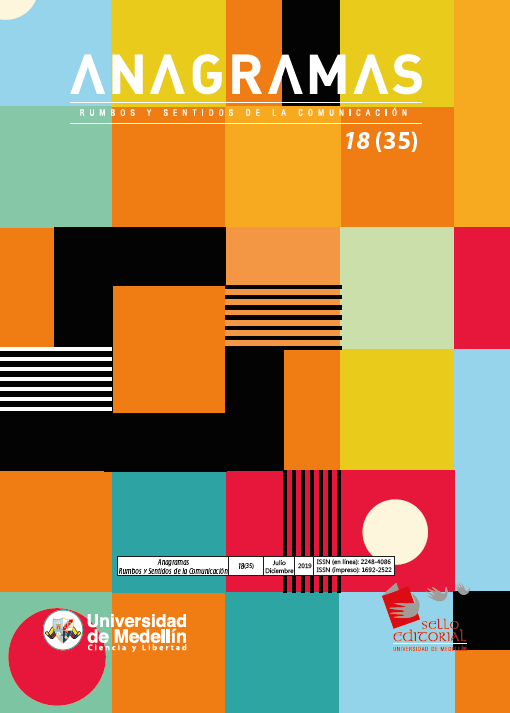Humanity’s expensive banalities. Virtual Reality mediated Advertisement exploration for raising environmental awareness: augmented advertisement
Copyright and Licensing:
Copyright (c) 2023 Anagramas Rumbos y Sentidos de la Comunicación

This work is licensed under a Creative Commons Attribution-NonCommercial-NoDerivatives 4.0 International License.
- Articles
- Submitted: June 12, 2018
-
Published: February 24, 2020
Abstract
The research engaged in this articles had as a goal analyzing the emotional perceptions of a focal group of young students from Fundación Universitaria los Libertadores with ages within a range from 17 to 23 years old, through an advertisement exercise that allowed the observation of the levels of remembrance generated by the exposition to the subjects of two advertisements in different time intervals: one of them with a traditional bidimensional format and the second one, the same piece translated into the emerging augmented reality technology. The methodology employed was an explorative one: it implied the development of three analysis and reading matrix-type tools. The first of them was composed for undergoing the translation process of the bi-dimensional piece to the enriched narrative with augmented reality, involving in its making which of the constitutive elements highlighted in importance over some that were not as important. The second one was employed for registering the emotional perceptions of the participants in the experiment, comparing the two kinds of pieces in two different moments; and with the third one, the aim was analyzing the attachment levels towards both pieces. These last two tools had as a goal registering the level of remembrance in time generated by the two spots presented. The research concludes that augmented reality generates impact among spectators and improves the remembrance capacity, but not in the levels expected. On the other hand, it is found that it was possible to incorporate positive design concepts for the translation and analysis of advertisements pieces that also work as a methodological medium for evaluating and registering the remembrance states. This facilitated the design and development process of an app for mobile devices as an extended augmented reality advertisement proposal —augmented advertisement—.References
- Alameda, D., y Fernández, E. (2002). Aproximación conceptual a la publicidad institucional. Sphera Pública, 2, 170-185.
- De Macedo, D., Rodrigues, M., Furtado, J., y Furtado, E. (2014). Using and evaluating augmented reality for mobile data visualization in real estateclassified ads. International Journal of Computers and Applications, 36(1), 7-14.
- Feng, Y., y Mueller, B. (2018). The State of Augmented Reality Advertising Around The Globe: A Multi-Cultural Content Analysis. Journal of Promotion Management, 1-23.
- Fontaine, G. (2004). Enfoques Conceptuales y metodológicos para una sociología de los conflictos ambientales. En: M. Cardenas y M. Rodríguez (Eds.), Guerra, sociedad y medio Ambiente. (pp. 503). Foro Nacional Ambiental.
- Fundación Telefónica (2011). Realidad aumentada: una nueva lente para ver el mundo. Editorial Ariel.
- Greenpeace. (2016). Which Side Are You On? United Kingdom. Recuperado de https://greenwire.greenpeace.org/uk/en-gb/blogs/which-side-are-you
- Hernández Sampieri, R. (2014). Metodología de la Investigación. McGraw-Hill Interamericana de España S.L.
- Hernández Sampieri, R., Fernández, C., y Baptista, P. (2014). Metodología de la investigación. McGraw-Hill.
- Jiménez, S., Pohlmeyer, A., y Desmet, P. (2011). Diseño Positivo. Guía de referencia. Ediciones Uniandes.Kotler, P. (1995). Dirección de Marketing. Prentice Hall.
- Marcuse, G. (2006). De la miseria humana en el medio publicitario. Melusina.
- Mattelart, A. (2000). La Publicdad. Paidós.
- Mugge, R., Schoormans, J., y Schifferstein, H. (2009). Emotional bonding with personalized products. Journal of Engineering Design, 20, 467-472.
- Russell, J. (2003). Core Effect and the psychological construction of emotion. Psychological Review, 110, 145-172.
- Sánchez, J. (1979). Introducción a la teoría de la publicidad. Tecnos.Scherer, K., Schorr, A., y Johnstone, T. (2001). Appraisal process in emotion: Theory, methods, research. Oxford University Press.
- Van Dyke, M., y Tedesco, J. (2016). Understanding Green Content Strategies: An Analysis of Environmental Advertising Frames From 1990 to 2010. Routledge.
- Walter, M. (2009). Conflictos ambientales, socioambientales, ecológico distributivos, de contenido ambiental... reflexionando sobre enfoques y definiciones. Boletín ECOS, (6), 2-9.
- World Wide Fund (wwf) (2017). Colombia Viva. Un país megadiverso de cara al futuro.wwf Colombia.
- Yaoyuneyong, G., y Foster, J. F. (2014). Factors impacting the efficacy of augmented reality virtual dressing room technology as a tool for online visual merchandising. Journal of Global Fashion Marketing, 283-296.
- Yaoyuneyong, G., Foster, J., Johnson, E., y Johnson, D. (2016). Augmented Reality Marketing: Consumer Preferences and Attitudes Toward. Journal of Interactive Advertising, 16(1), 16–30.
How to Cite
Puentes Castañeda, V. H., & Bohórquez, R. A. (2020). Humanity’s expensive banalities. Virtual Reality mediated Advertisement exploration for raising environmental awareness: augmented advertisement. Anagramas Rumbos Y Sentidos De La Comunicación, 18(35), 177-214. https://doi.org/10.22395/angr.v18n35a10
Downloads
Download data is not yet available.




























